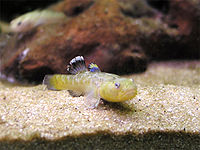Australian Desert Goby (Chlamydogobius eremius)
From The Aquarium Wiki
(Redirected from Australian Desert Goby)
Australian Desert Goby
Chlamydogobius eremius
38 Litres (10 US G.)
5.1-6.4cm (2-2.5 ")
Freshwater
7.0 - 8.0
10 -30 °C (50-86°F)
9-19 °d
1:2 M:F
1-1.5 years
Family
Gobiidae
This animal is available captive bred
Contents
Additional names
- Australian Desert Goby, Desert Goby
Additional scientific names
- Gobius eremius
Origin[edit]
- Endemic to South Australia.
Sexing[edit]
- Males are more colourful and larger than the females.
Breeding[edit]
- Spawning generally occurs in caves at temperatures above 26°C (78.8°F) . Females typically lay 50-250 eggs on the ceiling of a cave, with males guarding the eggs until hatching, which typically occurs in 10 days. Newly hatched fry are around 0.5cm (0.2") long and are large enough to eat newly hatched brine shrimp.
Tank compatibility[edit]
- This fish is territorial and will chase other fish away from its cave, however it will not chase far. Males can be somewhat aggressive toward each other, but little harm is done if the defeated male can get out of the winner’s line-of-sight.
Diet[edit]
- Prefers live foods, but will occasionally take frozen foods, especially frozen brine shrimp, daphnia and bloodworms. Frozen foods are often ignored once they settle on the bottom.
Feeding regime[edit]
- Feed once or twice a day.
Environment specifics[edit]
- Prefer a sandy bottom with plenty of rocks and caves. A fairly hardy fish to a wide range of conditions, including salinity. Field observations and laboratory experimentation indicate that it can withstand wide ranges of temperature (5-41°C (41-105.8°F) ), salinity (0-60 p.p.t.), pH (6.8-11.0) and very low dissolved oxygen level.
Behaviour[edit]
- Very poor swimmers; these Gobies get around by hops and scoots and enjoy plenty of rock or PVC pipe caves to explore and play on.
Identification[edit]
- Males have a golden yellow body and boldly coloured blue, black and white bands on their fins. The first dorsal of some males is tipped with lemon yellow. Females are generally various shades of light brown with clear fins.
- They are small fish, with a large male barely crossing the 6.4cm (2.5") mark. Females are a bit smaller, reaching about 5.1cm (2") inches. Their heads are very large, sometimes seeming as if they are too big for the fish.
Pictures[edit]
External links[edit]
- Fishbase (Mirrors:
 )
)
